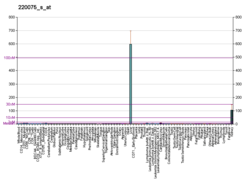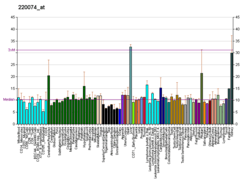MUPCDH
Mucin and cadherin-like protein is a protein that in humans is encoded by the MUPCDH gene.[5][6][7]
This gene is a novel mucin-like gene that is a member of the cadherin superfamily. While encoding nonpolymorphic tandem repeats rich in proline, serine and threonine similar to mucin proteins, the gene also contains sequence encoding calcium-binding motifs found in all cadherins. The role of the hybrid extracellular region and the specific function of this protein have not yet been determined. Alternative splicing has been identified, with observed variation resulting in the presence or absence of domains. In addition, splicing occurs in the 5' UTR but transcripts including these variations have not been described completely.[7]
References
- 1 2 3 ENSG00000273572 GRCh38: Ensembl release 89: ENSG00000099834, ENSG00000273572 - Ensembl, May 2017
- 1 2 3 GRCm38: Ensembl release 89: ENSMUSG00000025497 - Ensembl, May 2017
- ↑ "Human PubMed Reference:".
- ↑ "Mouse PubMed Reference:".
- ↑ Paris MJ, Williams BR (Jan 2001). "Characterization of a 500-kb contig spanning the region between c-Ha-Ras and MUC2 on chromosome 11p15.5". Genomics. 69 (2): 196–202. doi:10.1006/geno.2000.6339. PMID 11031102.
- ↑ Goldberg M, Peshkovsky C, Shifteh A, Al-Awqati Q (Sep 2000). "mu-Protocadherin, a novel developmentally regulated protocadherin with mucin-like domains". J Biol Chem. 275 (32): 24622–9. doi:10.1074/jbc.M000234200. PMID 10801787.
- 1 2 "Entrez Gene: MUCDHL mucin and cadherin-like".
Further reading
- Yagi T, Takeichi M (2000). "Cadherin superfamily genes: functions, genomic organization, and neurologic diversity". Genes Dev. 14 (10): 1169–80. doi:10.1101/gad.14.10.1169. PMID 10817752.
- Goldberg M, Wei M, Tycko B, et al. (2002). "Identification and expression analysis of the human mu-protocadherin gene in fetal and adult kidneys". Am. J. Physiol. Renal Physiol. 283 (3): F454–63. doi:10.1152/ajprenal.00012.2002. PMID 12167596.
- Strausberg RL, Feingold EA, Grouse LH, et al. (2003). "Generation and initial analysis of more than 15,000 full-length human and mouse cDNA sequences". Proc. Natl. Acad. Sci. U.S.A. 99 (26): 16899–903. doi:10.1073/pnas.242603899. PMC 139241. PMID 12477932.
- Goldberg M, Wei M, Yuan L, et al. (2003). "Biallelic expression of HRAS and MUCDHL in human and mouse". Hum. Genet. 112 (4): 334–42. doi:10.1007/s00439-003-0907-7. PMID 12589428.
- Clark HF, Gurney AL, Abaya E, et al. (2003). "The Secreted Protein Discovery Initiative (SPDI), a Large-Scale Effort to Identify Novel Human Secreted and Transmembrane Proteins: A Bioinformatics Assessment". Genome Res. 13 (10): 2265–70. doi:10.1101/gr.1293003. PMC 403697. PMID 12975309.
- Ota T, Suzuki Y, Nishikawa T, et al. (2004). "Complete sequencing and characterization of 21,243 full-length human cDNAs". Nat. Genet. 36 (1): 40–5. doi:10.1038/ng1285. PMID 14702039.
- Liu T, Qian WJ, Gritsenko MA, et al. (2006). "Human Plasma N-Glycoproteome Analysis by Immunoaffinity Subtraction, Hydrazide Chemistry, and Mass Spectrometry". J. Proteome Res. 4 (6): 2070–80. doi:10.1021/pr0502065. PMC 1850943. PMID 16335952.
- Kimura K, Wakamatsu A, Suzuki Y, et al. (2006). "Diversification of transcriptional modulation: Large-scale identification and characterization of putative alternative promoters of human genes". Genome Res. 16 (1): 55–65. doi:10.1101/gr.4039406. PMC 1356129. PMID 16344560.
This article is issued from
Wikipedia.
The text is licensed under Creative Commons - Attribution - Sharealike.
Additional terms may apply for the media files.






